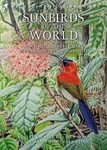Customer Reviews:
Diversity in a Uniform Bird Family
by Birdlover in the United Kingdom (21/12/2012)
Simply stunning. Buy it now.
Other reviews:
"British Birds and the British Trust for Ornithology announce the winner of the Award for Best Bird Book of the Year. All books reviewed in BB or the BTO publications BTO News and Bird Study (and on the BTO website www.bto.org) during the year 2012 were eligible for consideration for this Award.
The winner, The Reed Warblers: Diversity in a Uniform Bird Family (by Bernd Leisler and Karl Schulze-Hagen, illustrated by David Quinn, KNNV Publishing, 2011) is a wide-ranging review of the Acrocephalidae. This book sets the genera within a number of fascinating biological contexts and provides background to species that last year’s winner helps us to identify. It is full of comparisons, within the acrocephalids and between them and their New World counterparts, that provide extraordinary insights into the ecology of these species. A beautiful design and many first-rate drawings and photographs combine with erudite yet clearly written and informative text to make a book well worthy of our highest accolade."
– British Birds 106, March 2013
"What an extraordinarily diverse group of birds! This magnificent book provides a panoramic yet penetrating overview of the reed warbler's intriguing biology. Scholarly, yet readable and beautifully produced. A model of natural history writing and publishing."
– Tim Birkhead, Professor of Behavioural Ecology, University of Sheffield
"[...] this book should be read by not just warbler enthusiasts, but by all naturalists and students of behavioural and molecular ecology. The authors write with an evident love of their subjects, the text is both scholarly and a pleasure to read, and the whole is beautifully produced and illustrated. With few exceptions only English names of animal and plant species are used, and it is useful to learn (p. 327) that full names can be found in an appendix on the publishers' website."
– Françoise Dowsett-Lemaire, Bulletin of the African Bird Club 19(2), September 2012
"The Acrocephalidae, including the ‘true’ reed warblers Acrocephalus and the related genera, Iduna and Hippolais among others, are the archetypal small brown jobs. Given the lack of obvious plumage features of many of them, even quite distantly related species can present significant identification conundrums, and it is difficult to explain to non-birders why birders get so excited about them. Maybe non-birders should read this book.
In spite of what we might politely call the morphological subtlety of the birds themselves, this is not a field guide: it is a visually stunning survey of their lives. The authors are scientists and the level of detail is impressive – graphs, figures and maps in abundance – but this is a long way from being a dry science text. Starting broadly from the fact that reed warblers and their close relatives tend to look very similar to each other, a series of 15 chapters starts to explain the fascinating ways in which they are different, leading the reader through their systematics, niches and habitats, migration, ecology, breeding biology and behaviour. There are particularly interesting sections covering aspects of habitat preference, showing how different species are adapted to life in different vegetation structures and, for example, explaining such issues as the specific requirements of aquatic warblers A. paludicola. The reed warblers don’t exist in a vacuum, of course: they form part of a guild of insectivorous reedbed passerines (think of Eurasian reed warblers A. scirpaceus sharing their habitat with bearded tits Panurus biamarcus) and there are no acrocephalid warblers in the Nearctic, so there are chapters comparing their competitors and ecological equivalents in scrub and reed habitats worldwide. The Acrocephalus warblers in particular have a spectacular history of colonisation of island habitats – it is this aspect that may be less familiar to British Birds readers, and the relevant chapter is well worth a close read.
The knowledge and enthusiasm of the authors comes through clearly, and this represents accessible writing at its very best – clear explanation of sometimes quite complex subjects, with minimal jargon and statistics. The danger is that this book will not get the exposure and profile that it deserves – it seems to have evaded the attention of the online bibliophiles – which would be a criminal shame. Both content and presentation are of the highest quality; it deserves the widest possible readership and must be a contender for Bird Book of the Year."
– Martin Collinson, www.britishbirds.co.uk






















![Ageing & Sexing of Migratory East Asian Passerines [English / Chinese]](http://mediacdn.nhbs.com/jackets/jackets_resizer_medium/25/250760.jpg?height=150&width=115)






![Veldgids Diersporen Europa [Field Guide to Animal Tracks of Europe]](http://mediacdn.nhbs.com/jackets/jackets_resizer_medium/25/250295.jpg?height=150&width=101)


![Veldgids Vogeltrek in Beeld: Trekvogels Herkennen aan Hun Vliegbeeld [Field Guide to Bird Migration: Recognizing Migratory Birds by Their Silhouette]](http://mediacdn.nhbs.com/jackets/jackets_resizer_medium/26/263583.jpg?height=150&width=88)

![Veldgids Korstmossen [Field Guide to Lichens]](http://mediacdn.nhbs.com/jackets/jackets_resizer_medium/25/259434.jpg?height=150&width=101)


![Het Nachtvlinderboek: Macronachtvlinders van Nederland en België, Inclusief Rupsen [The Book of Moths: Nocturnal Macro-Moths of the Netherlands and Belgium, Including Caterpillars]](http://mediacdn.nhbs.com/jackets/jackets_resizer_medium/24/247580.jpg?height=150&width=113)

![Veldgids Hommels van Nederland en België [Field Guide to Bumblebees of the Netherlands and Belgium]](http://mediacdn.nhbs.com/jackets/jackets_resizer_medium/26/261396.jpg?height=150&width=101)